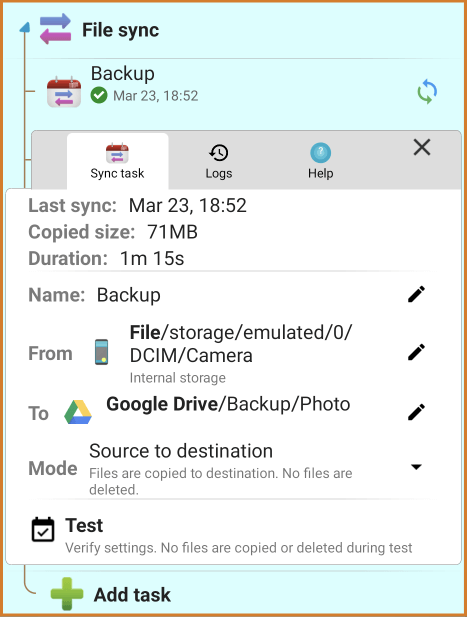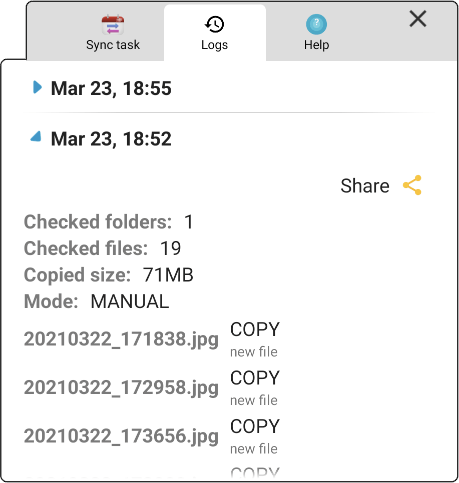ⓘ To enable the function, use Show button at bottom of list to show it.
File synchronization function allows you to configure synchronization of files between two folders in different locations. Such pre-configured task can be run later by single click of a button.
This allows to keep two folders in sync, where source and destination can be on local device or on remote cloud server.
You’ll get File sync tool by clicking on Show button at bottom of file list. A new item named File sync will appear, which you can open to get list of sync tasks. If there is none yet, click Add task button to add new task.
Each task can be clicked, then it will show its configuration and other useful tabs to work with.
In main tab, you can see status of task, and make configuration. You can configure:
- name of task
- source and destination folder
- mode of operation
At bottom is Test button which helps you to verify if configuration is correct, but it doesn’t make any changes to files. Results of test sync will appear below this button.

Usage scenarios for file sync:
- copy new photos from device to your PC
- bring files from cloud server to your device
- backup files from device to other location
- backup all installed apps
Folders in these locations are supported as source or destination:
- Internal storage
- SD card
- USB storage (partially)
- Cloud servers (Google Drive, Webdav, Owncloud, Nextcloud, OneDrive, Dropbox, pCloud)
- LAN
- FTP
- SSH
Mode of operation
Files are copied between two folders configured under From and To. You can configure mode specifying how files are actually copied:
- Source to destination (one way)
– source folders/files are copied to destination
– when file is deleted at destination, it is ignored until it is modified; if it’s modified at source, it’s copied again
– files deleted at source are left intact at destination
– files modified at source are copied to destination - Source to destination (full sync):
– source folders/files are copied to destination
– files deleted at destination are always copied back from source again
– files deleted at source are deleted also at destination
– files modified at destination are skipped
– files modified at source are copied to destination - Move:
– files and folders from source are copied to destination, and then deleted at source - Bidirectional full sync:
– new folders/files are copied to either direction
– deleted folders/files in one place are deleted on other place (if they were synced before)
First three modes treat From folder as source and To folder as destination. The Bidirectional mode treats both folders as both source and destination.
Schedule
You can run sync task manually, or schedule it to be run automatically in chosen times:
- Periodically after 15 or 30 minutes, 1, 2, 4, … hours, up to one day. Exact time when sync task is run is not known, it’s attempted to be run approximately after specified delay.
- Daily at same time.
When schedule is configured, sync task is attempted to run, but exact time may be offset by decision of Android system, taking into consideration battery power, charger state, network connectivity, device sleep, power saving, etc.
Logs
X-plore keeps logs of several last synchronizations, which you can see under Logs tab. You can see details of sync operation, including which files were copied or deleted, and reason for this (e.g. new file or changed file).
You can also share log (send to somewhere) if you would need to study it or send it somewhere.

Running sync task
File sync can be invoked manually by pressing sync button located on right side of the task, or it can run automatically by predefined schedule.
Additionally it’s possible to add shortcut to home screen, which will allow to run specific sync task from the home screen.